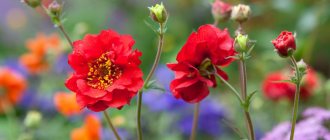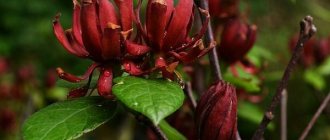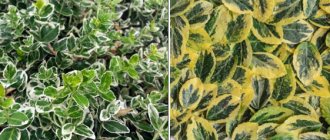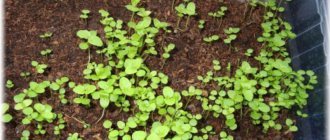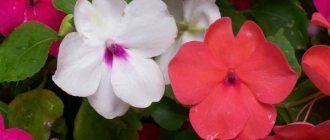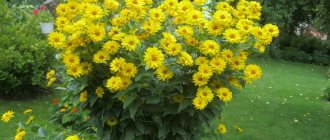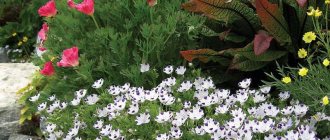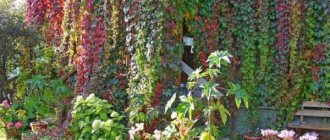Botanical description
Mesembryanthemum is a plant of the Aizaceae family. Depending on the type of flower, there are both annual representatives and biennial plants. A small flower reaching 30 cm in height is a succulent. It grows in the form of small bushes or subshrubs. In ordinary life, among gardeners and flower growers you can hear other names for this flower - midday, sunflower, sunflower, ice grass. However, the most common name for the flower is crystal daisy.
The roots are creeping, having a main rhizome from which a large number of lateral roots arise. Sunflower roots go deep into the ground to extract nutrients and water.
The stems are creeping or straight and have a large number of branches. Some species have recumbent or ascending stems, thickened at the base of the flower. There is a fluff on the surface of the stem, which prevents large amounts of moisture from appearing on the stem.
Crystal chamomile leaves are located on a short petiole, very close to the stem. The foliage of the flower is fleshy, densely covering the entire plant. different species have different leaf shapes - spindle-shaped or semicircular with smooth edges. There are varieties with oblong leaves. The leaves are arranged alternately, decreasing in size towards the tip of the stem. The peculiarity of the foliage of the mesembryanthemum is that the leaf blades have papillae filled with juice. Thanks to this structure, the leaves acquire a crystalline shine and additional brightness.
Crystal daisy blooms in inflorescences similar to daisies or carnations. The variety of species determines the different number of colors of plant buds. in natural and artificial habitats you can find mesembryanthemum blooming in red, white, pink, crimson and other shades. The petals of the flower are narrow and elongated. They have an oblong round shape. The diameter of flowers can reach 8 cm.
The peculiarity of this genus of plants is that the flowers hide and close into buds at night and in bad weather. The buds open only with the onset of clear sunny weather. In this case, the petals close or open as the climate and time of day change. The plant also enjoys long-term flowering, since the buds can remain in bloom from the beginning of summer until the end of autumn.
After flowering, a fruit is formed, consisting of a capsule containing seeds inside. Mesembryanthemum seeds are small, so up to 3 thousand seeds can fit in one box.
general information
The plant genus Mesembryanthemum belongs to the Aizaceae family. This name was coined for the plant by Jacob Breine in the 17th century and is derived from two Greek roots meaning “flower” and “noon”. It was originally written as Mesembrianthemum. This name was chosen because the flowers of all plants belonging to this genus known at that time opened only at noon, in sunny weather. At any other time, for example, at night or in the rain, they closed their petals.
Even in Russian literature, this flower is sometimes called by analogy “solar flower” or “midday”.
However, already in the 18th century, varieties of this plant were discovered, the flowers of which opened at night. Then the name was slightly adjusted by Johan Dillenius, a botanist from Germany. The Latin name took on a modern form, and new etymology suggested that it was derived from Greek roots meaning “middle” and “germ.”
Mesembryanthemum is an annual or biennial shrub up to fifteen centimeters high. This is a very low, sometimes creeping or creeping plant. It is classified as a succulent. Its stems usually lie on the ground, but have an upright shape.
The leaves of all representatives are green, large and fleshy. Their distinctive feature is the indispensable presence on the leaves of swollen cells that resemble crystalline droplets. Such an unusual structure gave this flower another name - “crystal daisy”.
The flowers of this plant can be either single or grow in inflorescences. They look like daisy flowers - they have many small, straight and narrow petals . Their colors are usually red, white or pink, sometimes yellow, but rarely. Small seeds are in the fruit-box.
As a rule, the main homeland of mesembryanthemum is called Southeast Africa , but it also grows in the wild in other places: for example, in South Australia, the Mediterranean and the Canary Islands.
Sandy soils drenched in sun are best suited for this flower.
Where does mesembryanthemum grow?
The growth of the flower in its natural environment is due to the presence of a warm temperate climate. The plant is thermophilic, which is why its homeland is South America and Africa.
In artificial habitats, sunflower can be found in temperate and hot climates of Europe and Asia. Midday grows in the Caucasus, the Canary Islands, southern Australia and the Mediterranean.
Mesembryanthemum prefers to grow in open areas. To create growing conditions, sunflowers need to be provided with constant sunlight and dry soil. The flower does not tolerate constant moisture, so it is almost impossible to find a growing sunflower near rivers and reservoirs. Sandstones and sandy loam soils are optimal.
Application in cosmetology
Mesembryanthemum has a unique ability to influence the skin at the cellular level, triggering renewal processes in it and neutralizing the effects of negative environmental factors. This explains its widespread use in cosmetology, in particular by the Yves Rocher company, which has its own plantations in La Gacilly for growing succulents. However, it is impossible to prepare a healing drug based on mesembryanthemum at home, since this requires a special technology of enzymatic cryoextraction.
Why crystal daisy
A common and frequently encountered name for mesembryanthemum is “Crystal Daisy”. The plant received this name due to the fact that there are fibers on the stem and leaves of the flower. When moisture and water get on the hairs, the sunflower shines in the sun, shimmering with all colors. It is especially beautiful to watch this state during the morning dew.
Externally, this plant looks like rock crystal. The inflorescences themselves are similar in shape and structure of the petals to field daisies. That is why the combination of these features and phenomena became the reason for renaming the mesembryanthemum to “Crystal Daisy”.
How the crystal daisy blooms
The flowers resemble field daisies in shape. About 30 buds can bloom simultaneously on one stem. At the same time, sunflower varieties can have red, yellow, pink and crimson shades. Midday blooms almost all summer and autumn. In sunny weather, the flowers completely cover the surface of the plant, forming a multi-colored blanket.
In the dark or in bad weather, the buds hide under the leaves. This creates a bright green canvas that shines beautifully in the light. Some species of sunflower bloom until frost.
Types and varieties
Midday has about 75 varieties. Most of the species are decorative hybrids grown under artificial conditions. In garden conditions you can find only a few varieties of crystal chamomile. Such varieties are more unpretentious to external influences and growing conditions.
Mesembryanthemum crystallinum
Under natural conditions, the plant is widespread in the southern regions of Africa. A perennial representative of the midday plant, growing low to the ground. The height of the stems of the variety reaches about 15-20 cm. The plant has a large number of branched stems, along which many small leaves grow densely.
The leaves of the sunflower have a pale green, rich color. The leaf blade has a rounded shape with wavy velvety edges. Some leaves are oblong. the leaves are adjacent to the stem due to the short petiole. The leaves grow opposite each other. The length of the leaves can reach from 2 to 20 cm, depending on the family and variety of mesembryanthemum.
The flowers are white or pink, some varieties are orange. Several can grow on one peduncle. However, lonely representatives are less common. The diameter of the flower reaches 8 cm. The shape of crystal grass flowers is similar to daisies or carnations. The petals are elongated, up to 5 mm wide, the length can exceed 5 cm.
Mesembryanthemum gramineus or tricolor
Representative of annual varieties of midday. The plant has an erect stem, up to 12 cm long. The peculiarity of the variety is the shades of the stem - reddish with glimpses of green in the middle of the stem. The leaves are fleshy and have a round or elongated shape. The surface of the leaf blade is completely covered with hairs. The leaf length reaches 5 cm.
Crystal daisy blooms in summer. At the same time, the flowers are small, up to 3.5 cm in diameter. The colors of the flowers vary from pink to crimson. A peculiarity of this species is the darkening of the shade as the petals move towards the center of the flower.
Daisy-shaped mesembryanthemum bellidiformis or hair-flowering mesembryanthemum
An annual plant, common in artificial growing conditions. The sunflower has a creeping, thickened stem. The flower has a large number of oval leaves covered with villi. The leaves grow up to 8 cm in length. Papillae are located across the entire surface of the leaf blade - pockets for collecting water and moisture, in which juice is formed. The color of the leaves is light green or light green.
The plant blooms with bright multi-colored inflorescences. The diameter of each bud is about 5 cm. The buds open only during clear weather. Different varieties of mesembryanthemum can bloom in yellow, orange, red, violet or purple.
Mesembryanthemum cloudy mesembryanthemum nubigenum
A perennial representative that grows in the form of small bushes. The height of the bush is 8-10 cm. The plant is frost-resistant, so the sunflower blooms in good weather until the first snow falls. In winter, the plant turns purple or bronze.
The stems are creeping and completely cover the area where the plant is planted. When combined with green foliage, crystal daisy forms a dense blanket that trails along the ground. Thanks to this, the plant is popular in decorative arts.
The leaves of this variety of crystal chamomile are oval in shape and reach 2 cm in length. small leaves tightly fit the branching stem. They have a bright green tint. The leaf shape is round with smooth edges.
The variety blooms in late spring and early autumn. The variety has a large number of varieties, which causes a variety of shades of inflorescences.
Growing cloud sunflower is prohibited in some countries because the plant can cause hallucinations.
Mesembryanthemum occulatus
A beautiful ornamental plant that grows up to 15 cm in height. The stem of the ocellated crystal daisy is creeping and thickened. The leaves reach 4 cm in length. The plant is quite popular among gardeners, thanks to the beautiful and unusual combination of shades of the inflorescence.
The peculiarity of the noon ocelli is its inflorescence, similar to a chamomile. The inside of the flower is painted red. The petals are usually yellow, but there are varieties with white and pink petals.
Crystal herb Frost beneficial properties. Crystal grass
Last year, a penfriend sent me tomato seeds. In the envelope I also found a transparent bag with small, dust-like seeds of a plant unknown to me - crystal grass.
“Is it worth sowing?” – I thought. There was almost no information about it, except that it looks amazingly beautiful and that in the fall, once in a vase with water, even without roots, it grows, blooms and can produce seeds. In the spring, I sowed it in a small bowl on top of light soil and I put it in a small greenhouse where early cabbage was already sprouting. Occasionally I moistened it with water from a spray bottle, and after a week and a half, shoots appeared.
Leaves are like drops of water
These were unusual shoots, I had never seen anything like them before. Tiny leaves are like emerald drops of water. When the sun's rays hit them, they shimmered in different colors. After the seedlings had grown stronger, I prepared a light nutrient soil for planting them: I mixed soil from the garden bed, river gray sand and peat for seedlings in equal proportions. I swooped down with a fork, prying the plant from below, and transferred it to a cup with soil. Then I sprinkled it lightly and poured it from a spoon under the root. I’ll tell you, the appearance of the shining “crystal grass” was so unreal that I was haunted by doubts: will it take root? But everything went well, not a single root died, although I did not hide them from the sun. The sparkling carpet retained moisture! The growth of these amazing plants began. I didn’t know how much my crystal grass would grow, but somehow I figured out to plant it sparingly, not sparing the land. The distance between the bushes gradually decreased, although they did not grow in height. The branches were pressed to the ground, stretching in different directions. There was the previous impression that there were droplets of water on them, but they were quite hard to the touch. And the leaves took on bizarre shapes, increased in size and, of course, sparkled with all the colors of the rainbow in the sun. In general, the entire plant simply radiated light, it was impossible to pass by. By the middle of summer, mind you, with almost no watering, the bushes of crystal grass closed in on the garden bed, completely covering the soil. It was always cool under this sparkling carpet; the ground did not overheat. When in the fall I discovered that the roots of this grass were surprisingly small, I realized that my “crystal” beauty did not draw water from the ground at all, on the contrary, it retained it!
The seeds go to the attic, and the branches go to souvenirs. One day, approaching the garden bed, I saw fluffy white stars and realized: the crystal grass has bloomed! It bloomed until late autumn, and the first buds managed to produce boxes with seeds. I dried them along with the bushes and hung them in the attic by their roots. Now I’ll cherish it like the apple of my eye until next spring. In the fall, at the exhibition of the Kursk club “Gardener”, crystal grass captivated everyone with its unusual appearance and iridescent shine. The women instantly sorted out its branches for souvenirs. By that time, I already knew that the Latin name of this amazing plant is Mesembrianthemym cristalliym and it belongs to the Aizoaceae family. It turns out that crystal grass is 99% water. And that is not all.
Photosynthesis changes
The most interesting thing is that this plant is able to change its type of photosynthesis depending on the ambient temperature. In the spring, when the air is generally cool and humid, the stomata on the undersides of the leaves are open, and the grass absorbs carbon dioxide during the day and releases oxygen. In the summer, when it becomes dry, hot and the salinity of the soil increases, then the crystal grass switches to another type of photosynthesis, in which the stomata close during the day. As a result, water evaporation is reduced by 10 times. We can say that this plant has phenomenal resistance to drought and salinity. I can already imagine how next summer the “crystal” carpet will protect my tomatoes from changes in night and day temperatures. With crystal grass you can forget about mulching, it will retain moisture.
What do you know about her?
By the way, I also found information that crystal grass juice, if applied to the face, makes the skin smooth and velvety. To check, she picked off a leaf and rubbed it on her cheeks, then another one. Surprisingly, the skin became silky and the feeling of dryness disappeared. So the “crystal” leaves helped me out all summer, and at the end of autumn I sent them “in bulk” to freeze, and in the winter they reminded me of summer every day. And also, I thought, I could try treating the seeds of garden crops before sowing with the juice of these frozen leaves.
Caring for mesembryanthemum at home
Planting crystal daisy in open ground will allow the plant to bloom only in hot climates. Therefore, many gardeners grow the flower at home. In addition, to plant a plant in the ground, you first need to grow seedlings. To do this, plant the plant seeds in containers.
Growing from seeds
Growing midday from seeds is done in April, since during this period there is enough light for germination of sprouts. To grow mesembryanthemum, you need to prepare light, well-drained soil. You can buy special soil in the store, or you can prepare the substrate yourself. To do this, mix equal parts of peat and sand mixture, add half of the garden soil.
Before planting seeds, the soil should be treated to remove bacteria; to do this, water the soil with a weak solution of potassium permanganate or heat it in the oven. After which the soil should remain warm for several weeks to provide the plant with the optimal amount of nutrients.
Immediately before planting in the ground, the soil is watered with clean distilled water. It is important to understand that the plant does not require a large amount of water, so the olive oil should be moderate, without the formation of a water layer.
Seeds are planted without first leveling or making holes in the soil. Since the seeds are very small, they are evenly distributed over the soil surface, lightly pressing the soil layer.
To quickly germinate seeds, the container is covered with polyethylene and placed in a sunny place. It is important to ventilate the container daily, opening the container for several hours during periods of bright sunlight. At room temperature, sprouts appear in about a few days. The majority of sprouts germinate within a month.
An important point in growing sprouts is to lower the temperature to 12 degrees as soon as the plants emerge from the ground. After the appearance of the main number of sprouts and their rooting, the film is removed from the surface of the container. There is no need to water the soil after sowing the seeds, since condensation is created under the film, which is optimal for germination.
How to water and feed
After the seedlings emerge and the film is removed, the seedlings should be watered regularly. Since the plant is very fragile and is not firmly attached to the ground, regular watering can break and destroy the sprouts. Therefore, moistening the soil with sprouts should come from a spray bottle. Watering should be done once every two to three days.
After the sprouts become stronger and more than three permanent leaves appear on the stem, the plants are transplanted into separate containers. And when constant heat appears outside and the soil warms up, the mesembryanthemum is transplanted into open soil.
When growing mesembryanthemum at home, the plant does not need constant feeding. During the period of germination of sprouts in containers, it is worth feeding the sprouts only 1-2 times. To do this, you need to spray the soil with a special complex fertilizer.
How to plant mesembryanthemum
These flowers can be propagated vegetatively and generatively (by seeds).
Vegetative propagation
In the fall, after flowering has ended, you need to select well-developed healthy adult specimens and divide them into cuttings, which are stored in a cold, dark room (recommended temperature +10C). Transfer for planting in open ground is carried out in the spring, depending on the climatic zone and weather conditions from March to May. After planting, it is important to organize the correct watering regime. On the one hand, it is necessary to create conditions for successful rooting, for which the soil should not be excessively dry, on the other hand, succulents do not like excess moisture and rot easily.
Important! Mesembryanthemum cuttings are prone to rotting when stored in an excessively humid room.
How to plant mesembryanthemum seedlings?
Flowers can be grown either by sowing in open ground or by seedlings. The second method is more popular and more reliable. The algorithm for its implementation is common. In light and loose soil with a predominant sand content, mesembryanthemum seeds are planted using the surface method, without deepening. Seeds are sown in March or April. The germination of crystal chamomile seeds lasts for 2 years and has high rates. The top of the crop is covered with film to create greenhouse conditions. This is the only period in the life of the mesembryanthemum when it requires high humidity at home. However, the temperature should not be too high, but rather cool.
Description and photo of a plant called Hoya multiflora. Flower care at home
Shoots appear unevenly, the first shoots can be seen after a week, the bulk will appear over the next 2.5-3 weeks. After this, it is important to provide the seedlings with high-quality lighting. Watering is done extremely moderately; the soil should not be wet, but only slightly damp; short-term drying is allowed. The room temperature should be cool or even cold.
When to dive?
Mesembryanthemum does not like replanting due to its rapidly expanding root system, so if possible, it is better to avoid picking by immediately planting the seeds in separate containers, 2-3 per pot. If this is not possible, picking should be done as early as possible, at the growth stage of 2-3 leaves. No root pinching is required.
When to plant seedlings in open ground?
The usual time for planting seedlings is late May or early June. Young seedlings grown at home do not tolerate frost well. In the case of gradual hardening, the dates may be shifted to the beginning of May. The planting scheme for ordinary ground cover species is 10*15 cm. Tall varieties with long shoots are planted half as often.
Planting and caring for mesembryanthemum in open ground
Growing mesembryanthemum at home is carried out only until permanent leaves form on the sprout. Subsequently, the plant is picked and placed in open ground. It is important to understand that the flower grows only in warm climates. Therefore, for normal growth and long flowering, it is worth following some rules.
What time to plant
Planting a flower in an open area after frosts have passed and after constant heat has formed, the sunflower is planted in flower beds or gardens. At the end of May and beginning of June, the flower is planted in open soil with well-drained soil.
Landing rules
When planting sunflowers, it is worth considering some rules that will create optimal comfortable conditions for the plant and provide the opportunity to delight with beautiful flowers for a long time.
The sunflower should be planted in an open, well-ventilated area. With lots of sunshine and warmth. The plant does not tolerate drafts, so it is important to protect the flower from the wind. The optimal conditions for growing crystal chamomile are the southern sides of the garden, without large bushes and trees near the flowerbed.
To plant a plant, dig a hole in the ground that is suitable in size to the length of the plant.
rhizomes of the sprout. After this, the plant is taken out of the container and, together with a lump of earth, is placed in the hole. It is worth digging the roots on top and watering them with water. A distance of 20 cm should be maintained between plant bushes.
How to take care of the garden
In garden growing conditions, the mesembryanthemum is regularly watered. In this case, watering is carried out when the flower drops its leaves and begins to suffer from thirst. Watering should be moderate, since high humidity is detrimental to the roots and stem. If there is excess moisture, the sunflower stops blooming. To keep the plant in good condition on rainy days, covering material is placed on top of the bushes.
When grown in the garden, the plant should be fed with complex fertilizers. It is worth applying liquid fertilizers twice a month.
It is also not worth trimming the leaves and stems of the mesembryanthemum. Because the creeping stems form a beautiful multi-colored carpet over the surface of the ground. Under optimal growing conditions, the shrub blooms in mid-summer and retains buds until the first frost.
Wintering
When growing perennial varieties of mesembryanthemum, with the onset of frost, the flowers are dug out of the ground and cleared of excess soil mixture. The plant must be stored in a cool, bright place, maintaining temperatures up to 12 degrees.
With the onset of spring, crystal daisy is cut and left in sunny places until roots appear, occasionally watering the flowers. After the onset of warmth, crystal chamomile is planted in the ground again.
The resting period of the mesembryanthemum
During the dormant period, dug out flowers also require watering. In this case, the plant is sprayed with water about 1-2 times a month. The room with mesembryanthemum cuttings should not be damp, as the flowers may rot.
At high temperatures, the flower may begin to germinate in the middle of winter, which is fraught with rotting and disease. If the temperature remains normal, the plant survives the winter well. In the spring, roots quickly appear on the cuttings; they can be planted in open ground only with the onset of warm weather.
Rules of care
The mesembryanthemum does not require special care, however, for its optimal development, you still need to comply with several simple care conditions.
Lack of light negatively affects the plant: it stretches upward, and mesembryanthemum flowers may not be seen at all in such an environment. Therefore, it is best to pay attention to this even during planting, choosing an area with good lighting for it. If this condition cannot be met, you can place special spotlights next to it, which will make up for the lack of illumination.
During the growth period of the plant, it is necessary to fertilize it at least twice. And it is best to fertilize even more often - twice every month, from May to September.
This tropical guest is not afraid of droughts, and even a long period without watering is not so terrible for him. It tolerates heat well, although it is still better to water it during especially hot periods.
If the summer is cold and rainy, it is best to stop watering completely, otherwise the mesembryanthemum may die.
But this flower does not tolerate cold. Even with a slight cold snap, you can cover it without letting it freeze. It is not capable of wintering in most regions of Russia - the minimum temperature at which it can survive is +10 degrees. Therefore, for the winter it is best to dig it up and keep it in pots. If such troubles do not suit the gardener, then this plant can be grown as an annual crop.
Reproduction
If it is necessary to breed the species, the plant can be propagated in two ways - by growing the variety from seeds or increasing the number of crystal daisies by vegetative means.
Propagation by cuttings
Mesembryanthemum is propagated by cuttings in March, when the perennial flower is harvested after a dormant period. Only healthy bushes that have survived the winter well are propagated.
For propagation by cuttings, the plant after wintering is divided into daughter cuttings. The resulting shoots are placed in damp coarse sand. After planting, it is necessary to keep the plant without watering for several days. After this, the sprouts should be watered in a tray under the flower pot. It is important to provide moderate watering so as not to rot the sprouts. Cuttings do not like stagnant water, so it is worth watering with clean water.
After the first leaves appear on the crystal chamomile sprouts, the plant should be dug out from the sand mixture. If the weather outside is normal at this time, the mesembryanthemum is transplanted into open ground. If weather conditions suffer frosts, then the bushes should be kept at home, planted in well-drained soil.
Under optimal conditions, after the roots appear, crystal chamomile quickly takes root and produces a large number of leaves. The flower also grows quickly.
Growing from seeds
The plant is planted in open ground only in southern climate zones. In temperate climates, seeds are planted in the spring in containers that are placed on a well-lit surface.
Seeds are planted in a container with drained soil. When sowing, it is worthwhile to level the sowing as much as possible over the surface, trying to distribute the seeds. After sowing, a small amount of sand is added on top, but not more than 3 mm above the surface of the seeds. The crops are covered with film to create condensation. You should not water the plants while they are under the film. For optimal growth, you should regularly ventilate your seed containers.
After the flowers germinate, the film is removed from the surface of the container. Watering is carried out through a tray no more than twice a week. Sprouts do not tolerate drafts, so seedlings must be placed in a warm, sunny place. The main leaves of the sprouts appear approximately 3-4 weeks after planting. Then the mesembryanthemum dives.
When to sow mesembryanthemum for seedlings
Sow mesembryanthemum in late March - early April. Earlier sowing will lead to stretching of seedlings (lack of light affects). Seedlings become brittle and develop poorly.
How to sow
- The seeds are scattered over the surface as little as possible; it is better to immediately use a toothpick and place them at a distance of 2-3 cm, so as not to break them later, damaging the roots.
- lightly sprinkle sand on top;
- the embedment depth does not exceed 2 - 3 mm;
- maintain temperature +12-15º C;
- crops are sprayed with a spray bottle and covered with film;
- shoots emerge on the 7-8th day (the main ones - after 21-28 days), then the film is removed and transferred to a bright windowsill without drafts;
- seedlings that are too elongated are treated with retardants, which slows down excessive growth in length and increases the division of stem cells in width;
- water moderately, preventing the roots from rotting;
- the temperature is reduced to + 10º C;
- grown seedlings, at the stage of appearance of two to four true leaves, are planted in separate pots or cassette cells.
- Further care consists of maintaining moderate humidity of the substrate, providing bright diffused lighting and a cool temperature within 10-16 °C.
Diseases and pests
Crystal chamomile is a fairly unpretentious plant that is rarely susceptible to disease and pest attacks.
Diseases
If overwatered, the plant may stop blooming and begin to rot. In insufficient light, the buds do not open and the leaves fade. After eliminating and optimizing watering, the leaves grow back, creating a beautiful blanket on the surface of the earth.
Harmful insects
The only pest that is dangerous to the flower is the spider mite. Regular spraying of the stem and leaves with a fungicide solution will eliminate the problem.
Mesembryanthemum in landscape design
The beauty of the plant determines the frequent use of crystal daisy in design art. The plant in landscape design goes well with roses or cornflowers. The blanket that forms the stem and foliage of the crystal daisy looks good even when the buds are closed. Therefore, mesembryanthemum is often planted together with growing tulips and irises. After the bulbous flowers fade, crystal chamomile shoots appear, which will make the flowerbed design unusual. The plant feels good on balconies and terraces.

